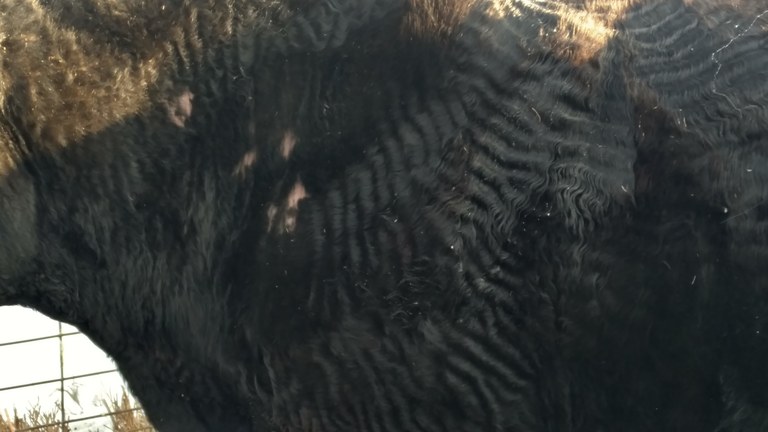Scratch, scratch, scratch…Are cattle lice the problem?
As the daylight hours lengthen and the temperatures start to warm up we also see cattle starting to rub. With their full, heavy winter coat of hair, it’s easy to think that the cows are hot and are ready to get rid of extra hair. Besides, it’s been a long time since a nice summer shower has rinsed the dust off the cattle.
However, scratching and rubbing can also indicate that cattle have a lice infestation. Lice don’t like the summer sun and warm temperatures, so summer time lice infestations in cow herds is usually not a problem. Besides, some fly control practices can control lice.
However, winter time can lead to outbreaks of hair loss. Scratch. Scratch. Rub. Rub. The cattle are uncomfortable and are likely dealing with lice. Cattle that are thin and dealing with cold stress seem more susceptible to lice outbreaks.

The pink areas on this cow's neck are exposed skin due to hair loss from a lice infestation.
Don’t confuse hair loss due to lice with hair loss due to the fungal infection called ringworm. Ringworm isn’t a worm, it is a fungus that commonly grows in areas around the eyes, head, shoulders, and tail head but can be found anywhere else. Ringworm is spread by contact and is also present in the facilities. Eventually, most cattle will develop an immunity to the fungal infection and hair will regrow in a month.
Lice don’t just go away. There are two types of lice – biting and sucking. Sucking lice feed off the blood of the host by piercing the skin and sucking blood. Biting lice feed off the skin tissues. Either type of lice are uncomfortable to the cow.
Treatment is simple. Find an insecticide labeled for lice control on cattle and apply.
However, cattle that have been treated with an insecticide in the fall can still have a January through March outbreak. Why? Many possible reasons.
Lice are shared between animals by contact. So if one animal was missed and not treated or an untreated animal was added to the herd, that animal is a source of repopulating the lice through the herd. Treat each animal.
The population of lice on a cow is relatively low coming off of pasture in November. It takes a while to grow a population of lice that is bothersome to a cow. Cattle are also spread out more on pasture than during winter feeding. Close winter contact leads to sharing lice.
Biting lice need to be treated so that the insecticide reaches the lice. Topical treatments of insecticide are usually applied as pour-ons or spot-ons. The lice need to migrate from the shoulders or tail area over the back to where the insecticide is applied to be killed. Lice do migrate but it takes time. Also, lice eggs (nits) can hatch and if the insecticide doesn’t have a long enough residual (greater than 21 days), retreatment will be needed.
Total body submersion (dip tank) works great for getting total body coverage of insecticide in the summer. Obviously, dip tanks are not advised in cold North Dakota winters.
Systemic insecticides, like the avermectin series, work well on both types of lice. However, lice can become resistant to insecticides. If the previous insecticide didn’t control the lice, you will need to switch to a different class of insecticide.
If you see cattle rubbing, it’s likely to be time to delouse. The good news? Lice are species specific, so cattle lice are not transferred to the owner.
NDSU does not endorse commercial products or companies even though reference may be made to tradenames, trademarks or service names.
Karl Hoppe, Ph. D
Karl.Hoppe@ndsu.edu
Area Extension Specialist/ Livestock


